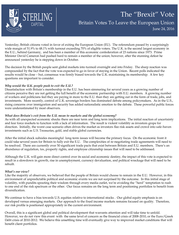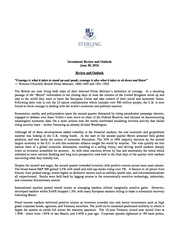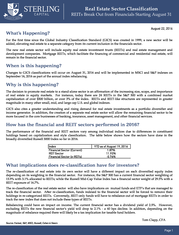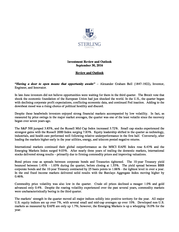Description
Page 6
social and economic destiny, the near term impact of this vote is expected to result in a slowdown in growth, rise in
unemployment, currency devaluation, and short term political void. Similar reactions will ripple through other
international markets in both developed and emerging markets. Although unsettling in the near term, non-U.S.
markets continue to represent over 50% of global capitalization, provide positive growth opportunities, and offer
improving valuations.
Our fixed income strategy has not been materially impacted by recent events. We have positioned our portfolios
defensively with intermediate and long-term portfolios managed short versus their benchmarks.
Gradual improvement in the economy favors overweighting corporate securities relative to Treasury and agency bonds. Municipal bonds have performed well making them modestly expensive relative to taxable securities. We have shifted our view on the Fed’s next move in interest rates. Our expectation was that the Fed would move to raise short term rates at mid-year.
Although the Fed’s posture remains biased towards higher rates, global volatility and the impending presidential election should keep the Fed on the sidelines until year end. We believe active asset allocation allows investors to take advantage of opportunities as they arise. When we see these situations developing we will take appropriate actions in a thoughtful and deliberate way. Although making near term market predictions is a futile exercise, we are confident of one market forecast for the second half of 2016 – that is, we assure you the market will be filled with unplanned surprises and scary volatility. However, maintaining a thoughtful and consistent approach to the markets will allow us weather the storms that are ahead. The opinions contained in the preceding commentary reflect those of Sterling Capital Management LLC, and not those of BB&T Corporation or its executives. The stated opinions are for general information only and are not meant to be predictions or an offer of individual or personalized investment advice.
They also are not intended as an offer or solicitation with respect to the purchase or sale of any security. This information and these opinions are subject to change without notice. Any type of investing involves risk and there are no guarantees. Sterling Capital Management LLC does not assume liability for any loss which may result from the reliance by any person upon any such information or opinions. Investment advisory services are available through Sterling Capital Management LLC, a separate subsidiary of BB&T Corporation. Sterling Capital Management LLC manages customized investment portfolios, provides asset allocation analysis and offers other investment-related services to affluent individuals and businesses.
Securities and other investments held in investment management or investment advisory accounts at Sterling Capital Management LLC are not deposits or other obligations of BB&T Corporation, Branch Banking and Trust Company or any affiliate, are not guaranteed by Branch Banking and Trust Company or any other bank, are not insured by the FDIC or any other government agency, and are subject to investment risk, including possible loss of principal invested. .
Gradual improvement in the economy favors overweighting corporate securities relative to Treasury and agency bonds. Municipal bonds have performed well making them modestly expensive relative to taxable securities. We have shifted our view on the Fed’s next move in interest rates. Our expectation was that the Fed would move to raise short term rates at mid-year.
Although the Fed’s posture remains biased towards higher rates, global volatility and the impending presidential election should keep the Fed on the sidelines until year end. We believe active asset allocation allows investors to take advantage of opportunities as they arise. When we see these situations developing we will take appropriate actions in a thoughtful and deliberate way. Although making near term market predictions is a futile exercise, we are confident of one market forecast for the second half of 2016 – that is, we assure you the market will be filled with unplanned surprises and scary volatility. However, maintaining a thoughtful and consistent approach to the markets will allow us weather the storms that are ahead. The opinions contained in the preceding commentary reflect those of Sterling Capital Management LLC, and not those of BB&T Corporation or its executives. The stated opinions are for general information only and are not meant to be predictions or an offer of individual or personalized investment advice.
They also are not intended as an offer or solicitation with respect to the purchase or sale of any security. This information and these opinions are subject to change without notice. Any type of investing involves risk and there are no guarantees. Sterling Capital Management LLC does not assume liability for any loss which may result from the reliance by any person upon any such information or opinions. Investment advisory services are available through Sterling Capital Management LLC, a separate subsidiary of BB&T Corporation. Sterling Capital Management LLC manages customized investment portfolios, provides asset allocation analysis and offers other investment-related services to affluent individuals and businesses.
Securities and other investments held in investment management or investment advisory accounts at Sterling Capital Management LLC are not deposits or other obligations of BB&T Corporation, Branch Banking and Trust Company or any affiliate, are not guaranteed by Branch Banking and Trust Company or any other bank, are not insured by the FDIC or any other government agency, and are subject to investment risk, including possible loss of principal invested. .









